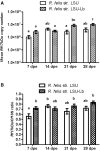Effect of Rickettsia felis Strain Variation on Infection, Transmission, and Fitness in the Cat Flea (Siphonaptera: Pulicidae)
- PMID: 28399259
- PMCID: PMC5850810
- DOI: 10.1093/jme/tjx046
Effect of Rickettsia felis Strain Variation on Infection, Transmission, and Fitness in the Cat Flea (Siphonaptera: Pulicidae)
Abstract
Rickettsia felis is a human pathogen transmitted by the cat flea, Ctenocephalides felis (Bouché) (str. LSU), as well as an obligate symbiont of the parthenogenic booklouse Liposcelis bostrychophila (Badonnel) (str. LSU-Lb). The influence of genetic variability in these two strains of R. felis on host specialization and fitness and possible resulting differences on infection and transmission kinetics in C. felis is unknown. Utilizing an artificial host system, cat fleas were exposed to a R. felis str. LSU-Lb-infected bloodmeal and monitored for infection at 7-d intervals for 28 d. Quantitative real-time PCR was used to determine rickettsial load and infection density in newly exposed cat fleas, and transmission frequency between cat fleas. The effect of persistent R. felis infection on cat flea F1 progeny was also assessed. At 7 d postexposure 76.7% of the cat fleas successfully acquired R. felis str. LSU-Lb. In R. felis str. LSU-Lb-exposed cat fleas, the mean infection load (6.15 × 106), infection density (0.76), and infection prevalence (91/114) were significantly greater than R. felis str. LSU infection load (3.09 × 106), infection density (0.68), and infection prevalence (76/113). A persistent R. felis str. LSU-Lb infection was detected for 28 d in adult cat fleas but neither female:male ratio distortion nor vertical transmission was observed in F1 progeny. While infection kinetics differed, with higher intensity associated with R. felis str. LSU-Lb, no distinct phenotype was observed in the F1 progeny.
Keywords: Ctenocephalides felis; Liposcelis bostrychophila; Rickettsia felis strain; cat flea; infection kinetics.
© The Authors 2017. Published by Oxford University Press on behalf of Entomological Society of America.
Figures



Similar articles
-
Genomic diversification in strains of Rickettsia felis Isolated from different arthropods.Genome Biol Evol. 2014 Dec 4;7(1):35-56. doi: 10.1093/gbe/evu262. Genome Biol Evol. 2014. PMID: 25477419 Free PMC article.
-
Molecular Detection of Rickettsia felis in Humans, Cats, and Cat Fleas in Bangladesh, 2013-2014.Vector Borne Zoonotic Dis. 2016 May;16(5):356-8. doi: 10.1089/vbz.2015.1886. Epub 2016 Feb 22. Vector Borne Zoonotic Dis. 2016. PMID: 26901499
-
Dissemination of bloodmeal acquired Rickettsia felis in cat fleas, Ctenocephalides felis.Parasit Vectors. 2013 May 24;6:149. doi: 10.1186/1756-3305-6-149. Parasit Vectors. 2013. PMID: 23705666 Free PMC article.
-
Prevalence of Rickettsia felis DNA in the blood of cats and their fleas in the United States.J Feline Med Surg. 2007 Jun;9(3):258-62. doi: 10.1016/j.jfms.2006.12.005. Epub 2007 Feb 2. J Feline Med Surg. 2007. PMID: 17276123 Free PMC article. Review.
-
Ecology of Rickettsia felis: a review.J Med Entomol. 2009 Jul;46(4):723-36. doi: 10.1603/033.046.0402. J Med Entomol. 2009. PMID: 19645274 Review.
Cited by
-
Rickettsia felis: A Review of Transmission Mechanisms of an Emerging Pathogen.Trop Med Infect Dis. 2017 Dec 19;2(4):64. doi: 10.3390/tropicalmed2040064. Trop Med Infect Dis. 2017. PMID: 30270921 Free PMC article. Review.
-
Vector biology of the cat flea Ctenocephalides felis.Trends Parasitol. 2024 Apr;40(4):324-337. doi: 10.1016/j.pt.2024.02.006. Epub 2024 Mar 7. Trends Parasitol. 2024. PMID: 38458883 Free PMC article. Review.
-
Cat Flea Coinfection with Rickettsia felis and Rickettsia typhi.Vector Borne Zoonotic Dis. 2024 Apr;24(4):201-213. doi: 10.1089/vbz.2023.0122. Epub 2024 Mar 1. Vector Borne Zoonotic Dis. 2024. PMID: 38422214 Free PMC article.
-
Unpacking the intricacies of Rickettsia-vector interactions.Trends Parasitol. 2021 Aug;37(8):734-746. doi: 10.1016/j.pt.2021.05.008. Epub 2021 Jun 21. Trends Parasitol. 2021. PMID: 34162522 Free PMC article. Review.
-
A One Health Perspective on the Resurgence of Flea-Borne Typhus in Texas in the 21st Century: Part 1: The Bacteria, the Cat Flea, Urbanization, and Climate Change.Pathogens. 2025 Feb 5;14(2):154. doi: 10.3390/pathogens14020154. Pathogens. 2025. PMID: 40005529 Free PMC article.
References
-
- Adams J. R., Schmidtmann E. T., Azad A. F.. 1990. Infection of colonized cat fleas, Ctenocephalides felis (Bouche), with a rickettsia-like microorganism. Am. J. Trop. Med. Hyg. 43: 400–409. - PubMed
Publication types
MeSH terms
Grants and funding
LinkOut - more resources
Full Text Sources
Other Literature Sources
Miscellaneous

